
© Evan Li. (Click image for larger version)
Royal New Zealand Ballet
Made to Move: The Anatomy of a Passing Cloud, Of Days, Bier Halle
Auckland, ASB Theatre
8 March 2013
www.nzballet.org.nz
The Royal New Zealand ballet began their 60th anniversary celebrations with a triple bill of new 30-minute works being presented throughout New Zealand from late February to late in March. Two were new commissions from returning guest choreographers – The Anatomy of a Passing Cloud by London-based Venezuelan, Javier de Frutos, and Of Days by Berlin –based New Zealander, Andrew Simmons. The third, Bier Halle, is the first work on the company by artistic director Ethan Stiefel following his successful collaboration with Johan Kobborg in staging Giselle.
Three radically different worlds are conjured up by strongly contrasting styles of dancing, music, set and design – a warmly-lit, intricately-patterned world of danced ritual and Cook Islands quilting; a mysteriously immersive world of measured pace and glimmering light, and a nineteenth century Bavarian beer hall animated by Straussian polkas, marches and waltzes.
The Anatomy of a Passing Cloud by Javier de Frutos, like his earlier work for the company, Milagros, has a feeling of ritual and community. It opens with a prayer, perhaps a blessing for the day, passing around the circle of gathered dancers, and closes with a solo which includes a long look out into the auditorium (the world beyond the dance, perhaps into the future?). In between, there’s a sense of time passing busily, of daily interactions, socialising, gatherings of one size or another, a little flirtation, some more meaningful personal exchanges, some face-offs, some settling of scores.
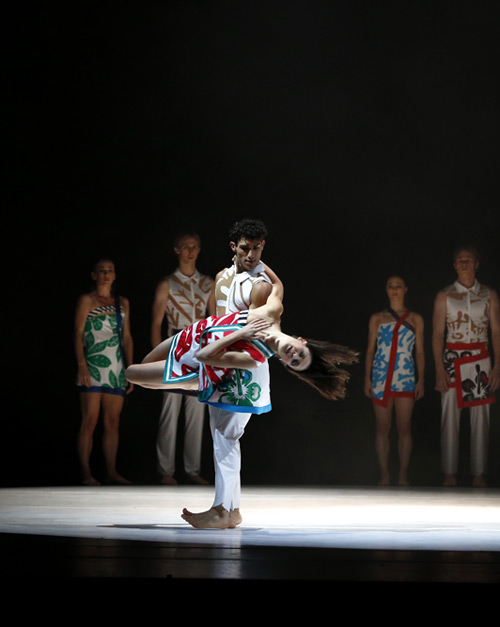
© Evan Li. (Click image for larger version)
The twelve dancers in this cast are more often onstage than off, watching from the shadows when not dancing. Interlacing, swirling sequences of circle dances break out into squares, wedges and triangles of quartets, trios and duets, and the occasional solo, before returning to the whole group in circle formation once again. At the heart of the community is an alpha male, a man of rank and power (Dimitri Kleioris) who throughout the work asserts his preferences by claiming dancing partners, and his dominance by lowering selected individuals to the ground with one hand pressed to his or her forehead.
The movement vocabulary is highly articulate and intricately patterned, embellished by flicks and flourishes and an intermixing of sharp cuts and extended curves. These moves have little in common with traditional Pacific dances, and more closely resemble the detailing of tivaevae, the distinctive Cook Islands quilting which is the primary design element in the costumes worn by both men and women.
Tivaevae designs are based on flowers, usually with a single flower comprising the design, cut and pieced together in fabric of an intense, single colour, which is then appliqued onto a white background and further quilted. Such quilts are highly valued and are gifted to mark significant life events – weddings, coming of age ceremonies and so on.
The men each wear a micro-length, tivaevae-decorated lavalava over white trousers and stretchy white tops patterned with fawn burned-out flowers. The women wear tivaevae-patterned micro-length A-line halter dresses over white briefs. Each tivaevae design is highly individual, with a single colour quilted onto white – the floral elements for both men and women being in shades of purples, blues, greens, and one in red (worn by the highest ranking woman, Abigail Boyle).
The dancing is phrased to match the rhythms and cadences of the accompanying sound sources, ranging from ancestral songs to contemporary choral singing, iconic Pacific popular songs from the 1950s, Cook Islands log drums, and a Bible reading from Genesis recounting the earth’s creation.
Anatomy of a Passing Cloud is more intricate and complexly detailed than Milagros was, and the dancers are well able to meet the technical requirements. When the pace is at its fastest, Madeleine Graham delivers a firecracker solo; and when it is at its most langorous, Abigail Boyle and Lucy Balfour are meltingly marvellous. Boyle and Kleioris in particular have gone beyond mastery to a level of flow and release that make the movement even more compelling to watch, and their partnering has a beautiful sense of balance.

© Evan Li. (Click image for larger version)
Of Days, the new Andrew Simmons ballet, is a delicately immersive work for eight dancers set to trancelike, adagio-paced minimalist music, largely piano and strings, from composers Olafur Arnalds, Dustin O’Halloran and Ludovico Einaudi.
The work is darkly lit by Jason Morphett (who lights all three works) with lighting initially sparse, offering only glimpses and glimmers of dancers who appear and disappear at a deliberately measured adagio pace as if by magic, dressed in shades of grey by Kate Venables – unitards for the men and leotards topped by chiffon for the women. The stage seems vast, a world of shadowy layers created using dark scrims and haze, and a series of drops create alternating frames, with the dancers dwarfed by the tall backdrop, letter-boxed into seeming much larger, turned into slim silhouettes far upstage, or made monumental by a suffusing glow of light.
Surtitles mysteriously appear and then fade into the dark again. One sequence of words morphs its way from “we see what we must” to “we see what we want”, “we seek what we want” and “we live without what we want”. There are gorgeous cameo solos and beautiful sequences of partnering – the lighting makes it hard to be sure just who to credit for what. Mayu Tanigaito is noticeable early in the work, with secure, deep chasses, lunges and arabesques; Brendan Bradshaw and Antonia Hewitt have an exquisite, extended partnering section, and Abigail Boyle is serene in several solos.
It feels like meditation, and it looks like astral planes, and there’s a sense of past, present and future merging together. Best to simply let yourself be taken on the journey.
Ethan Stiefel’s Bier Halle provides a considerable contrast to the other two works, not in the least because the stage is filled by a full-blown ornately detailed 19th century Bavarian beer hall (designed by Allan Lees), replete with carved wall panels, mounted stags’ heads, an oversize cuckoo clock, swinging doors, bench tables and several points of entry.
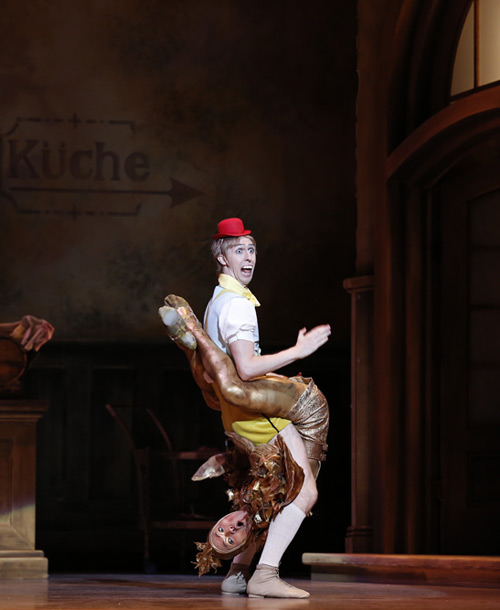
© Evan Li. (Click image for larger version)
The suitably-dressed local denizens slowly populate the bar – Barkeeper and Beer Maiden (Gillian Murphy), Baker and Butcher, various Townsladies and Townsmen, a Hunter (Qi Huan) with a brace of dead animals which he gifts to the barkeeper, a Beer Distributor (Sir Jon Trimmer), and also Studs and Flirts and a Nerd (Paul Mathews). They’re there to have a rollicking good time, with lots of drinking and dancing, foot-slapping, flag waving and sausage slinging. There’s some noticeable sneaking out for assignations on the side. And the Cuckoo in the clock (Kohei Iwamoto) comes to life and camply flaps his way through the fray, with some bravura sequences entrancing The Nerd and leading him a merry dance before it’s all over.
The lighting is bright, and the music is an extraordinary series of polkas, marches and waltzes by Strauss brothers Josef and Johann II which the women mostly dance en pointe!
It’s all rather preposterous, pretty much a mashup of 21st century comedy and cirque (such as gymnastic and stunt manouevres), with honouring of the 19th century ballet conventions. The group dances are impeccably performed, and the divertissements are too, of course, but it’s hard not to wince when The Beer Maiden and the Hunter pick their way on tippy toes through the first part of a waltz before letting her take the second half swirled through the air suspended from his shoulders, and when she launches into the famous Pizzicato Polka with rapidly picked up pointes. The Hunter continually ups the ante in his solos as a way to keep her eyes on him rather than on the Cuckoo.
Whether you love it or hate it (there seems to be no middle ground) you are bound to laugh at least some of the time.
The company’s 60th anniversary season continues with a five-centre tour to China with Giselle during April, followed by a remounting of Sir Russell Kerr’s iconic 1985 Swan Lake for a national tour during July and September, and the annual small centres Tutus on Tour during October and November.










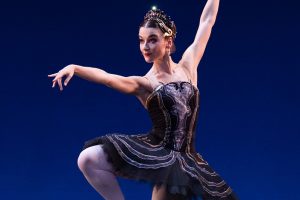


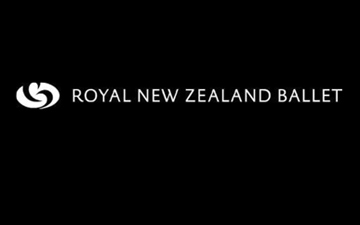
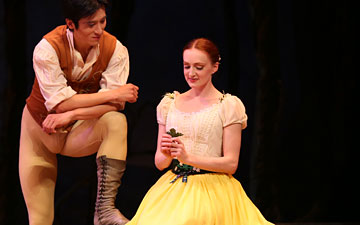
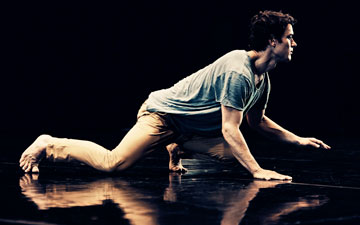

You must be logged in to post a comment.